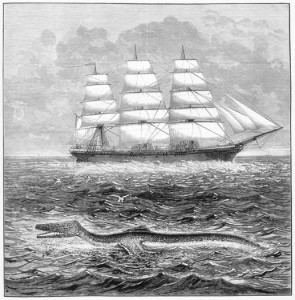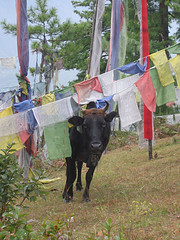 One if by land, two if by sea. And it was the sea that the two of them came on—first, an 18-foot-long fish spotted by a snorkeling science teacher off California’s Catalina Island last week. Fifteen people had to haul the creature to shore.
One if by land, two if by sea. And it was the sea that the two of them came on—first, an 18-foot-long fish spotted by a snorkeling science teacher off California’s Catalina Island last week. Fifteen people had to haul the creature to shore.
And then, on Friday, a slightly smaller one—just 14 feet—washing in with the waves on an Oceanside beach. A crowd gathered on the beach around the second silvery fish. Someone called the police and said it was a whale.
No wonder it was hard to recognize the strange creature. Oarfish, the world’s longest bony fish, can dive to 3,000 feet and are rarely seen at the surface unless they’re in distress. The legend of the sea serpent may have started when sailors saw a failing oarfish in the waves—but an oarfish would unlikely threaten a ship, with its tiny, toothless mouth.
In other news of legends unmasked, an Oxford researcher has been taking DNA samples of possible yeti sightings. In two cases, according to reports, the researcher linked DNA from hair samples of supposed yeti—or migois, as they are known in the Himalayas—to an ancient polar bear. It’s possible that this creature could be an undiscovered species, maybe a hybrid of polar and brown bear.
 One of the samples came from a reported yeti sample in Bhutan, which has a wildlife refuge dedicated to protecting the migoi; it also shelters snow leopard, Himalayan black bear, and a host of other species. When I visited Bhutan years ago, I didn’t see any yeti, but there was a kind of magic woven through everything. We hiked to a monastery that clung to a cliff, a place where Guru Rinpoche was said to have arrived on the back of a tiger. At a festival in the countryside, we streamed with a boisterous crowd beneath burning cedar boughs to scrub away our sins. The next day, our guides scrubbed their faces and filled their water bottles from a spring said to give good health. A doctor from Bumthang encouraged us to do the same. “You can drink the water, it’s good for your health,” he told us. “Even a scientist like me gets water here.”
One of the samples came from a reported yeti sample in Bhutan, which has a wildlife refuge dedicated to protecting the migoi; it also shelters snow leopard, Himalayan black bear, and a host of other species. When I visited Bhutan years ago, I didn’t see any yeti, but there was a kind of magic woven through everything. We hiked to a monastery that clung to a cliff, a place where Guru Rinpoche was said to have arrived on the back of a tiger. At a festival in the countryside, we streamed with a boisterous crowd beneath burning cedar boughs to scrub away our sins. The next day, our guides scrubbed their faces and filled their water bottles from a spring said to give good health. A doctor from Bumthang encouraged us to do the same. “You can drink the water, it’s good for your health,” he told us. “Even a scientist like me gets water here.”
And then there were places that, at first, seemed like the magic had been dulled by the everyday. Our guide wore high-tech wicking t-shirts under his traditional gho and played Counting Crows songs for us on his phone. One night we sat with a monk and his friends, all focused on a small television set playing old WWF wrestling matches. But then someone in the room said this: “It’s so beautiful, it’s like a dance.”
 Maybe I was wrong in trying to put things into categories: extraordinary, legendary, mundane. The last night we were in Bhutan, the power went out and the still air was full of laughter. Candles flickered in the grottos of small storefronts. Monks stood on street corners, their robes lit up in the blue of their cell phones. Even before we found still-cold beer at a hidden café, I understood that there was a part of me that could believe Guru Rinpoche had flown in on a tiger—and also that our plane would safely thread through the narrow valley and above the peaks the next day.
Maybe I was wrong in trying to put things into categories: extraordinary, legendary, mundane. The last night we were in Bhutan, the power went out and the still air was full of laughter. Candles flickered in the grottos of small storefronts. Monks stood on street corners, their robes lit up in the blue of their cell phones. Even before we found still-cold beer at a hidden café, I understood that there was a part of me that could believe Guru Rinpoche had flown in on a tiger—and also that our plane would safely thread through the narrow valley and above the peaks the next day.
Magic is where you find it, in pieces of DNA that hint at a still-mysterious new creature in the forest. Just like, seen from another angle, Hulk Hogan and Roddy Piper could be in a duet as intricate as a tango.
Sometimes, it can be disappointing—even soul-wrenching–to learn how things really work. I’d loved reading a recent profile of Apollo Robbins, a theatrical pickpocket based in Las Vegas—and then I cringed when I learned there was a video about how he did some of his tricks.
In the end, I couldn’t resist. But instead of feeling disillusioned, I was even more caught up—the artistry behind each wallet heist and watch removal was the most magical thing of all.
So Hulk up, yeti fans. There are more mysteries in store, as researchers trace the journey of genes that created this still-unknown creature in the Himalayas and try to find a living legend. Or an ROV may spot the streaming dorsal fin of a living oarfish while its small mouth sucks in plankton and miniature shrimp. And you never know what else will come in from the sea.
**
Top image: The ‘sea serpent’ as sighted by the man at the wheel of the Sacramento, en-route from New York to Melbourne, 24 November 1877, from Wikimedia Commons.
Thanks for your report on oarfish. On the morning news I heard about the beaching of two in Calif. and became curious to know more about them.